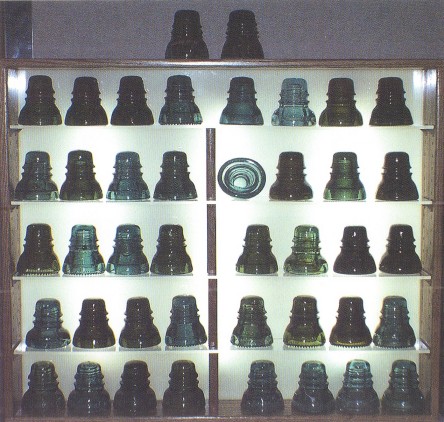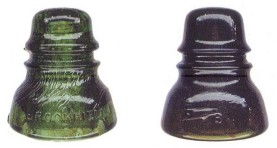NATIONAL - CD 152: The King of CDs and the CD of Kings
Reprinted from "Crown Jewels of the Wire", September 2000, (Insert) page 21
David French, St. Paul, Minnesota
NIA Award for Specialty
The CD 152 style was adopted by Western Union as their standard insulator in
1911, replacing the CD 145. Around this same time, Western Electric (AT&T)
adopted it as their standard insulator replacing the CD 121. This was the first
time all major US communication lines went to the same style for long lines.

The
two heavyweights of US glass insulator production, Brookfield and Hemingray,
hurriedly made up new mold sets for the CD 152 style, anticipating a huge demand
not only for new telephone lines but to rebuild aging telegraph and railroad
signal lines that had been constructed in the 1870s and 1880s. Between 1911 and
1921, these two companies made hundreds of millions of CD 152s, making it one of
the most popular insulator styles in North America. Hemingray had
unquestioningly the superior product. As collectors well know, the Hemi 40 tends
to be boring aqua glass, with only the occasional green coloration, bubbles,
amber or milky swirl, or mold deformity to break the monotony. Brookfield
production, on the other hand, is exactly the opposite.
Finding a Brookfield without the above mentioned defects is the exception,
rather than the rule. Brookfield hung in there, gamely trying to compete, but if
anything their quality got worse rather than better. Their units marked with the
style number "48" were probably among the last they produced and are
also some of the worst in quality.
Dave says: The title of this display, in case you didn't know, is supposed to
be a joke. CD 152 doesn't even come in royal purple, let alone have the cachet of
royalty. People ask me all the time, why collect CD 152? It has more than enough
strikes against it. Relatively modern, no color to speak of, common as dirt, a
successful but not a particularly inspired design, generated comparatively
little interest in the hobby.
I picked my first CD 152, a battered blue-aqua
Hemingray 40 (which I still have), off a low pole near a railroad roundhouse in
St. Paul, Minnesota in 1971. My collecting waxed. and waned over the next twenty
years until 1991 when I read in "The Rainbow Riders Trading Post" that
individuals were being declared "kings" of certain insulator
specialties. (Fred Padgett and his McLaughlins, Jimmy Burns and his J-D'S and
Rich Wentzel and his Whitall-Tatums) Now wouldn't that be neat, I dreamed, to be
the acknowledged subject matter expert for a small piece of this great hobby.
I needed an insulator that was common, cheap, could still be found in the wild,
and an insulator that no one else specialized in. Good old CD 152! Many
collectors struggle to keep up with the escalating prices in our hobby. A few CD
I52s have gone very high in Internet auctions, but for the most part they remain
relatively inexpensive. Over 80% of the pieces in this display were purchased
for $10 or less.

One of my favorite pieces is a Brookfield with an oval-shaped,
deformed skirt which was found by my friend Bruce Templeton on a line in Ontario
a few years ago. I also like the Brookfield No. 48 because they are crude. Every
piece seems to have a different interesting feature, and they are inexpensive. I
am currently looking for any CD 152 I don't have, particularly a smooth base
Hemingray 40; and unembossed CD 152, and a "tiger amber" embossed
"B ".

David French
|
